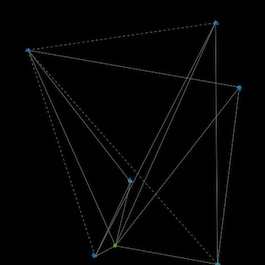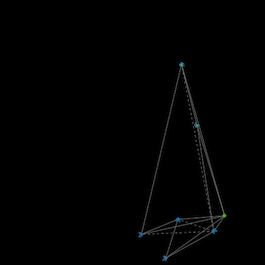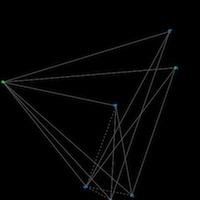|
Abstracts & Amplituhedrons: Exploring the Production & Storage of Knowledge
Introduction
The density and specialization of language in academic journals are persistent barriers to the liberation of bounded ideas that may be embedded within their pages. In this sense, storing knowledge in academic publications is not exactly effective or rigorous. It is difficult to access, both conceptually and financially. The abstract, a short summary that precedes many academic articles, is a varnished teaser or trailer for the knowledge promised within. These are often freely available from the publishers and databases which claim ownership over this knowledge. The following study examines academic abstracts as a site for archaeological excavation. The aim is to use the abstract to demonstrate the extent to which academic knowledge is estranged from local appreciation and application. To this end, a stylized visual representation of the abstract is offered in an attempt to elicit a more situated appreciation for the emergence of knowledge. As sites for excavation, abstracts share much in common with traditional archaeological sites. Each offers only a glimpse of the whole, fragmented collections of symbols from which larger interpretations may be drawn, rightly or wrongly. The following abstracts are taken (neither randomly nor methodically) from various articles pertinent to my own research. From each of these the number of words or concepts that would present a barrier to an uninitiated reader has been counted and raised exponentially by the number of appearances of these terms or phrases, this is in turn divided by the total number of words in the abstract. This pseudo-scientific jiggery-pokery is intended to emulate the increasing possibilities for interpretation that occur with distance (i.e., the time-distance between Paleolithic artifacts lends itself to a potentially greater number of interpretations than does a Medieval artifact). In this sense the more obscure the language, the more "wrinkled" the knowledge becomes (interpretations become folded over each other creating numerous dimensions of knowledge). This rather abstract (no pun intended) quantitative methodology will be visualized by the use of a helpful new shape recently discovered by theoretical physicists, the Amplituhedron (Arkani-Hamed), which if my rudimentary grasp of science is to be trusted, proves that locality and unitarity (not to mention time and space) are emergent phenomena, not embedded starting points. Localities are the consequence of estranged vantages. Taking this introduction as an example of the methodology, five opaque concepts have been identified, which recur nine times, and there are 716 words. Thus, the formula for determining the dimensions of estrangement generated by this production of knowledge is: (5 ^ 9) / 716 = 2728 (rounded). Thus, we will "fold" the amplituhedron 2728 times for each dimension the abstract is estranged from the local using the program NetLogo, originally designed to conduct experiments in agent-based modeling. The graphic depiction of an amplituhedron folded 2728 times will be presented alongside the abstract. The suggestion here is that knowledge can be produced through the emergence of localities, and stored in dimensional folds (distance from the local). Thus, esoteric knowledge can be folded any number of times but retain a localizable vantage. "Reading" the folds of the Amplituhedron traces the process of emergence. This is an attempt to radically operationalize and visualize Donna Haraway's situated knowledges. Situated knowledge relies less (overtly or implicitly) on principles derived from Enlightenment era scientific methods, which treat knowledge as accumulatory, perfectible, and lead to difficult to evade teleological tendencies.
Abstracts Perturbative scattering amplitudes in gauge theories have remarkable simplicity and hidden infinite dimensional symmetries that are completely obscured in the conventional formulation of field theory using Feynman diagrams. This suggests the existence of a new understanding for scattering amplitudes where locality and unitarity do not play a central role but are derived consequences from a different starting point. In this note we provide such an understanding for N = 4 SYM scattering amplitudes in the planar limit, which we identify as "the volume" of a new mathematical object -- the Amplituhedron -- generalizing the positive Grassmannian. Locality and unitarity emerge hand-in-hand from positive geometry. (Arkani-Hamed & Trnka 2013)
This article draws upon two concepts deployed by the American pragmatist philosopher Charles Sanders Peirce in his semiotic writings that have so far received little attention in studies of materiality and agency in archaeology, those of the "Interpretant" and "habit." The emphasis of both of these concepts on the interpretive side of semiotic functioning suggests that some of the problems with current theories of material agency may be due to their focus on the production of meaning rather than the recursive nature of meaning-making that requires consideration of the consumption side of meaningful communication acts as well. Using an example of pottery-making practices from the Early Bronze Age Black Sea region, this article argues that we should instead rethink agency as an "archaeology of self" in which identity and meaning of signs -- whether words, people, or things -- are distributed across and emergent from social networks and communities of interpreters. (Bauer 2013)
The extent to which colonizing farmer populations have overwhelmed or "replaced" indigenous forager populations, as opposed to having intermarried with them, has been widely debated. Indigenous-colonist "admixture" is often represented in genetic models as a single parameter that, although parsimonious and simple, is incongruous with the sex-specific nature of mtDNA and Y-chromosome data. To help interpret genetic patterns, we can construct useful null hypotheses about the generalized migration history of females (mtDNA) as opposed to males (Y chromosome), which differ significantly in almost every ethnographically known society. We seek to integrate ethnographic knowledge into models that incorporate new social parameters for predicting geographic patterns in mtDNA and Y-chromosome distributions. We provide an example of a model simulation for the spread of agriculture in which this individual-scale evidence is used to refine the parameters. (Bentley 2009)
In the anthropology of Christianity, and more broadly in the anthropology of religion, methodological atheism has foreclosed ethnographic description of God as a social actor. This prohibition is the product of certain ontological presumptions regarding agency, an absence of autonomy of human creations, and a truncated conception of what can be said to exist. Reading Tanya Luhrmann's recent ethnography, When God Talks Back: Understanding the American Evangelical Relationship with God (2012), in light of both the ontological postulates of Object Orientated Ontology and the work of Bruno Latour, this article proposes an ontological framework that makes it is possible to ethnographically describe God as a social actor without adopting methodological theism. This article also notes, however, that the ethnographic description of religious practice, found in studies of the Vineyard denomination such as Luhrmann's, challenge Latour's own account of the difference between science and religions as distinguishable enterprises. (Bialecki 2014)
A theory of the embodiment of action is proposed. Reflections on relations between human intentions, the human body and the notion of agency lead us to argue that phenomenological analysis is not sufficient for such a theory. Our consideration, that the most fundamental level of embodied agency is that of life itself, brings us to the philosophy of biology and the theory of the organism: briefly, certain parts of the natural environment are intrinsic to the constitution of organisms and, in their more sophisticated configuration, as agents. Action is embodied in the sense that certain physiological processes are internal in relation to it and play a constitutive role in its performance. The way in which environment, context and consciousness affect and constitute the nature of agency at personal and sub-personal levels is elaborated. We see that human agents perceive and act upon their world through a complex shifting between those levels. A summary of the ways in which the social sciences can be enriched by this more comprehensive view of human agency provides the basis of justification for claiming Actor-Network Theory (ANT), originally developed by sociologists studying science and technology, as a promising framework for the continuation of this reasoning. (Bruun 2003)
In the late nineteenth century, a high percentage of the Icelandic population emigrated to North America. In this article I bring to the fore two interrelated sites of tension in the emigrants' lives centered on the concepts of ethnicity and modernity. I will suggest that an analysis on how these tensions were mediated through material practices may be a fruitful way to provide a new understanding of the processes of emigration and cultural change, which aids movement away from dichotomous categories that have dominated previous research into the period. (Edwald 2012)
This essay argues that the Manchester case study method or situational analysis has theoretical implications more radical than Gluckman was in a position to see, implications bearing on the nature of the reality of society. In effect, the essay is an anthropological exercise in ontology. It maintains that the problems situational analysis was designed to address were integral to, and hence irresolvable in, the Durkheimian social ontology then characterizing British social anthropology, and that situational analysis insinuated an altogether different ontology. The latter is adumbrated here by appeal to certain Heideggerian concepts in an effort to bring into relief the unique capacity of situational analysis to capture social practice in its dynamic openness and, correlatively, in relation to human agency as a distinctively creative force. (Evans 2005)
Past discussions of Eastern Pueblo moiety organization in the American Southwest have been dominated by structural-functionalist positions and have proposed that moieties emerged in this area in order to facilitate the social integration of large, aggregated villages. This paper revisits the question of moiety origins from an archaeological perspective, presenting new data from the ancestral Northern Tiwa region that document the presence of a dual division as early as the late thirteenth century at the large village of T'aitöna (Pot Creek Pueblo). Consideration of the village's position within the local historical trajectory suggests that moieties were initially established there as a means of formalizing the social relationships between a local population and a recently arrived group of immigrants. The paper ends by arguing that these sorts of specific historical phenomena must be granted greater causal significance in the explanation of Eastern Pueblo moiety origins. (Fowles 2005)
Two studies examined the effects of self-uncertainty and ingroup entitativity on group identification. From uncertainty reduction theory (Hogg, 2000), it was hypothesized that people would identify most strongly with their group if they felt self-conceptually uncertain and the group was highly entitative. Study 1 was a field experiment (N = 114) in which the perceived entitativity of participants' political party was measured, and self-uncertainty was primed (high vs. low). Study 2 was a laboratory experiment (N = 89) with ad hoc non-interactive groups. Uncertainty was primed as in Study 1, but perceived entitativity was manipulated. In both cases the dependent variable was a multi-item measure of group identification. The hypothesis was fully supported in both studies -- participants identified more strongly when they were uncertain and the group was highly entitative. Implications of this research for the role of uncertainty and social identity in extremism, orthodoxy, and ideological belief systems are discussed. (Hogg 2006)
Over the past two decades, comparative linguistic anthropological research has disclosed the significance of meta-discourse and metasignaling for the establishment, maintenance, and transformation of social relations. One type of metasignal-signal relationship has, because of its role in producing sociability, come to seem especially interesting with regard to the evolutionary origins of human language -- the type wherein a strategically (and presumably neocortically) induced metasignal is modeled after, but distinct from, an instinctively triggered signal, as in ritualized lamentation. Strategic vocal deceptions in nonhuman primates are possible pre-cursors of true socially constructed, socially shared metasignals, which in turn may be ancestors of modern human language. This article charts an evolutionary path from strategic vocal manipulation, to cultural metasignals, to language, using data from primate studies, discourse-centered research, and early child language acquisition. (Urban 2002)
We propose that the emergent phenomenon known as "desakota," the rapid urbanization of densely populated rural populations in the newly developed world, particularly China, can be simulated using agent-based models that combine bottom-up actions with global interactions. We argue that desakota represents a surprising and unusual form of urbanization well-matched to processes of land development that are locally determined but moderated by the higher-level macroeconomy. We develop a simple logic that links local household reform to global urban reform, translating these ideas into a model structure that reflects these two scales. Our model first determines the rate of growth of different spatial aggregates using linear statistical analysis. It then allocates this growth to the local level using "developer agents" who determine the transformation or mutation of rural households to urban pursuits based on local land costs, accessibilities, and growth management practices. The model is applied to desakota development in the Suzhou region for the period 1990 to 2000. We show how the global rates of change predicted at the township level in the Wuxian City region surrounding Suzhou are tempered by local transformations of rural to urban land uses which we predict using cellular automata rules. The model is implemented in the RePast 3 software and is validated using a blend of data taken from remote sensing and government statistical sources. It represents an example of generative social science that fuses plausible behavior with formalized logics matched against empirical evidence, essential in showing how novel patterns of urbanization such as desakota emerge. Xie, Batty & Zhao 2007)
|











